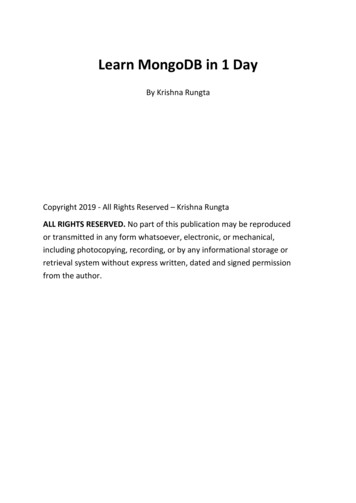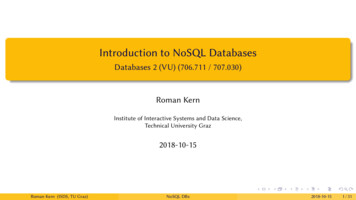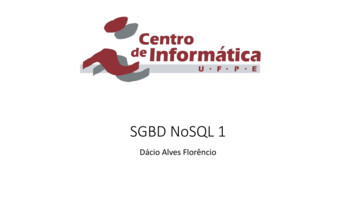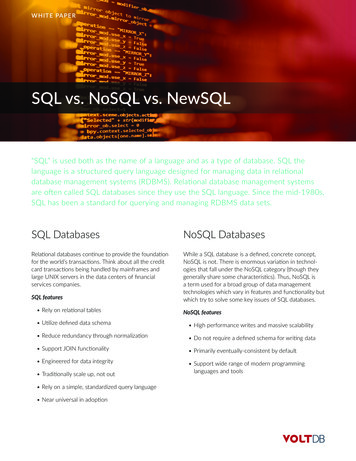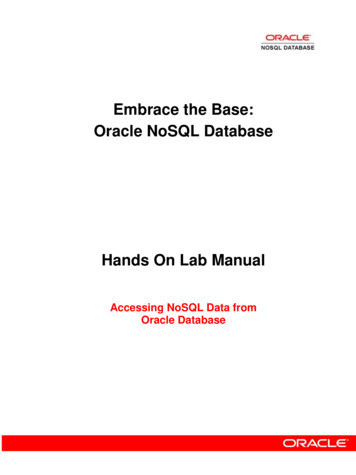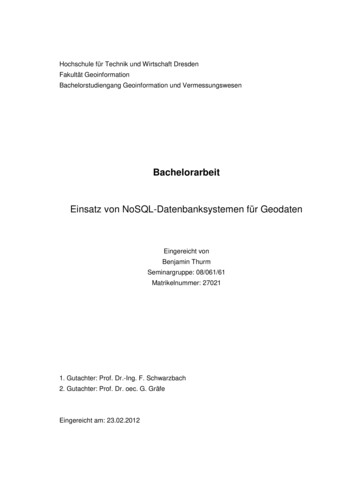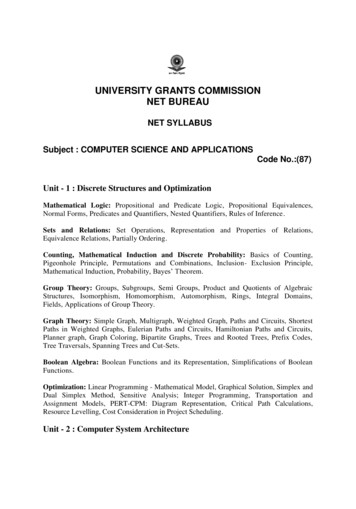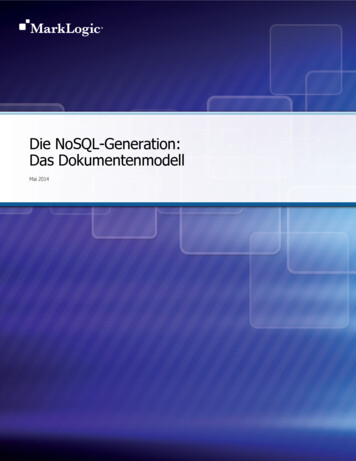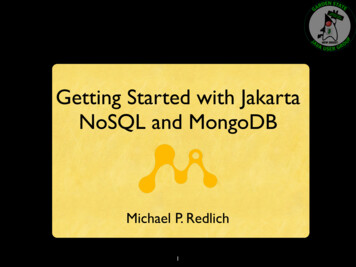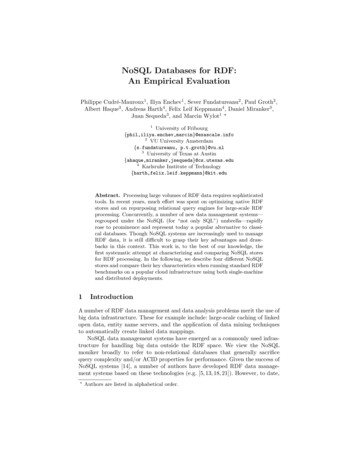
Transcription
Nov 15, 2013The Evolution of NoSQL – Part 2RFG POV: Unlike RDMS databases that are architecturally quite similar, NoSQL databases arenot and therefore, the classification is a misnomer. Whereas one could count the number ofenterprise-class databases (DBs) on one or two hands, the hierachical and requirements days are being supplemented by the compositeNoSQL genre. NoSQL databases in all their varieties are not going away any time soon and ITexecutives will need to understand the alternatives and select a minimum set that best meetscorporate needs.Part 1 covered the basic definitions and history of NoSQL. This research report addressesthe categories, funding and growth. Three more reports will follow that will cover 21NoSQL innovators worth exploring.NoSQL Database CategoriesAs will be seen in the following section, NoSQL DBs simultaneously defy descriptionand define new categories for NoSQL databases. Indeed, many NoSQL vendors possesscapabilities and characteristics associated with more than one category, making it evenmore difficult for users to differentiate between solutions. A good example is thefollowing taxonomy provided by Cloud Service Provider (CSP) Rackspace, whichclassifies NoSQL DBs by their data model.Copyright 2004-2013 Experture and Robert Frances Group, all rights reserved46 Kent Hills Lane, Wilton, CT. 06897; (203) 429 8951;http://www.rfgonline.com/; Contact: inquiry@rfgonline.com
Nov 15, 2013Note: In the original slide, Riak is depicted as a "Document" data model. According toRiak developer Basho, Riak is actually a key-value data model and its query API(application programming interface) is the popular web REST API as well as protocolbuffers.The chart above represents the five major NoSQL data models: Collection, Columnar,Document-oriented, Graph and Key-value. Redis is often referred to as a Column or Keyvalue DB, and Cassandra is often considered a Collection. According to Technopedia, aKey-Value Pair (KVP) is "an abstract data type that includes a group of key identifiersand a set of associated values. Key-value pairs are frequently used in lookup tables, hashtables and configuration files." Collection implies a way documents can be organizedand/or grouped.Yet another view, courtesy of Beany Blog, describes the database space as follows:"In addition to CAP configurations, another significant way data management systems vary is bythe data model they use: relational, key-value, column-oriented, or document-oriented (thereare others, but these are the main ones).Copyright 2004-2013 Experture and Robert Frances Group, all rights reserved46 Kent Hills Lane, Wilton, CT. 06897; (203) 429 8951;http://www.rfgonline.com/; Contact: inquiry@rfgonline.com
Nov 15, 2013 Relational systems are the databases we've been using for a while now. RDBMSsand systems that support ACIDity and joins are considered relational.Key-value systems basically support get, put, and delete operations based on aprimary key.Column-oriented systems still use tables but have no joins (joins must behandled within the application). Obviously, they store data by column as opposedto traditional row-oriented databases. This makes aggregations much easier.Document-oriented systems store structured 'documents' such as JSON or XMLbut have no joins (joins must be handled within the application). It's very easy tomap data from object-oriented software to these systems."Beany Blog omits the Graph database category, which has a growing number of entrantsin the space, including; Franz Inc., Neo4j, Objectivity and YarcData. Graph databases aredesigned for data whose relations are well represented as a graph – e.g., visualrepresentations of social relationships, road maps or network topologies andrepresentation of "ownership" for documents within an enterprise for legal or ediscoverypurposes.Hadoop and NoSQLThe Hadoop Distributed File System (HDFS) is an Apache open-source platform thatenables applications, such as petabyte-scale Big Data analytics projects, to potentiallyscale across thousands of commodity servers such as Intel standard x86 servers, dividingup the workload.HDFS includes components derived from Google's MapReduce and Google File System(GFS) papers as well as related open-source projects, including Apache Hive, a datawarehouse infrastructure initially developed by Facebook and built on top of Hadoop toprovide data summarization, query and analysis support; and Apache HBase and ApacheAccumulo, both open-source NoSQL DBs, which, in the parlance of the CAP Theorem,are CP DBs and are modeled after the BigTable DB developed by Google. Facebookpurportedly uses HBase to support its data-driven messaging platform while the NationalSecurity Agency (NSA) supposedly uses Accumulo for its data cloud and analyticsinfrastructure.In addition to the HBase, MarkLogic 7 and Accumulo native integrations of HDFS,several NoSQL DBs can be used in conjunction with HDFS, whether they are opensource and community supported or proprietary in nature, including Couchbase,MarkLogic, MongoDB or Oracle's version of NoSQL based on the Berkeley open-sourceDB. As Hadoop is inherently a batch-oriented paradigm, additional DBs to handle inmemory processing or real-time analysis are needed. Therefore, NoSQL – as well asRDBMS – solution providers have developed connectors for allowing data to be passedbetween HDFS and their DBs.Copyright 2004-2013 Experture and Robert Frances Group, all rights reserved46 Kent Hills Lane, Wilton, CT. 06897; (203) 429 8951;http://www.rfgonline.com/; Contact: inquiry@rfgonline.com
Nov 15, 2013The slide above, courtesy of DataStax, illustrates how NoSQL and Hadoop solutions aretransforming the way both transactional and analytic data are handled within enterpriseswith large volumes of data to manage both in real-time, or near real-time, and postprocessing or after data is updated or archived.NoSQL Funding and GrowthA recent note written by Wikibon's Jeff Kelly, Hadoop-NoSQL Software and ServicesMarket Forecast 2012-2017, gives a good indication of how well funded and fastgrowing the market for RDBMS alternatives has become."The Hadoop/NoSQL software and services market reached 542 million in 2012 asmeasured by vendor revenue. This includes revenue from Hadoop and NoSQL pure-playvendors – companies such as Cloudera and MongoDB – as well as Hadoop and NoSQLrevenue from larger vendors such as IBM, EMC (now Pivotal) and Amazon WebServices. Wikibon forecasts this market to grow to 3.48 billion in 2017, a 45% CAGR[compound annual growth rate] during this five-year period." Kelly forecasts the NoSQLportion of the market to reach nearly 2 billion by 2017.Copyright 2004-2013 Experture and Robert Frances Group, all rights reserved46 Kent Hills Lane, Wilton, CT. 06897; (203) 429 8951;http://www.rfgonline.com/; Contact: inquiry@rfgonline.com
Nov 15, 2013Kelly's research also indicates that the top ten companies in the space, measured inamount of funding dollars, received more the 600 million over the last 5 years, withfunding increasing dramatically over the last 3 years, including 177 million for 2013thus far. The top-funded NoSQL DB companies – in order of total funding amount –include DataStax (Cassandra), MongoDB, MarkLogic, MapR, Couchbase, Basho (creatorof Riak), Neo Technology (creator of Neo4j) and Aerospike.Note: On October 4th 2013, MongoDB announced it had secured 150 million inadditional funding which would now make it the top-funded company in the space.ConclusionSince no one type of NoSQL database neither satisfies all business requirements,innovators and venture capitalists will continue to invest in newer NoSQL iterations andvariations. This will just add to the confusion over the next four or five years while allthis slowly sorts out. Thus, while the market remains immature and the options aremyriad, IT executives cannot wait before selecting the right NoSQL platforms.RFG POV: The NoSQL wave of database technology is immature and expanding and amyriad of options exist to confound IT executives and slow down decision-making. ITexecutives and data architects should understand the variety of options and then mapthem to current and future business and technical requirements for each application typewhere a NoSQL database might apply. As pointed out in the report, no one solution maymeet all the requirements so IT executives should be prepared to act today and adopt andstandardize on a minimum set of multiple database solutions.Additional relevant research is available. Interested readers should contact ClientServices to arrange further discussion or interview with Mr. Gary MacFadden, PrincipalResearch Analyst.Copyright 2004-2013 Experture and Robert Frances Group, all rights reserved46 Kent Hills Lane, Wilton, CT. 06897; (203) 429 8951;http://www.rfgonline.com/; Contact: inquiry@rfgonline.com
(application programming interface) is the popular web REST API as well as protocol buffers. The chart above represents the five major NoSQL data models: Collection, Columnar, . MarkLogic, MongoDB or Oracle's version of NoSQL based on the Berkeley open-source DB. As Hadoop is inherently a batch-oriented paradigm, additional DBs to handle in-


